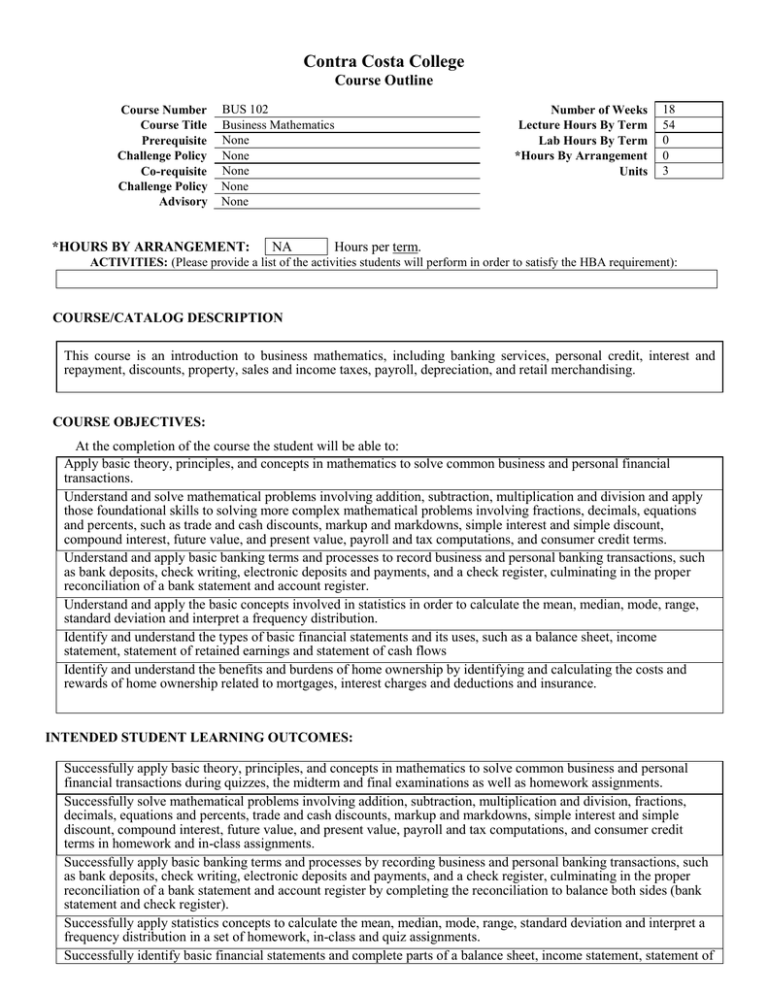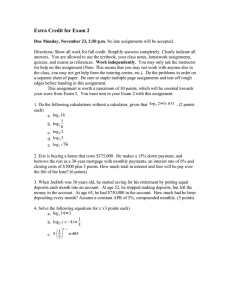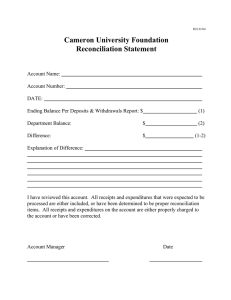BUS 102-S15.doc 92KB Feb 05 2015 08:29:26 AM
advertisement

Contra Costa College Course Outline Course Number Course Title Prerequisite Challenge Policy Co-requisite Challenge Policy Advisory BUS 102 Business Mathematics None None None None None *HOURS BY ARRANGEMENT: NA Number of Weeks Lecture Hours By Term Lab Hours By Term *Hours By Arrangement Units 18 54 0 0 3 Hours per term. ACTIVITIES: (Please provide a list of the activities students will perform in order to satisfy the HBA requirement): COURSE/CATALOG DESCRIPTION This course is an introduction to business mathematics, including banking services, personal credit, interest and repayment, discounts, property, sales and income taxes, payroll, depreciation, and retail merchandising. COURSE OBJECTIVES: At the completion of the course the student will be able to: Apply basic theory, principles, and concepts in mathematics to solve common business and personal financial transactions. Understand and solve mathematical problems involving addition, subtraction, multiplication and division and apply those foundational skills to solving more complex mathematical problems involving fractions, decimals, equations and percents, such as trade and cash discounts, markup and markdowns, simple interest and simple discount, compound interest, future value, and present value, payroll and tax computations, and consumer credit terms. Understand and apply basic banking terms and processes to record business and personal banking transactions, such as bank deposits, check writing, electronic deposits and payments, and a check register, culminating in the proper reconciliation of a bank statement and account register. Understand and apply the basic concepts involved in statistics in order to calculate the mean, median, mode, range, standard deviation and interpret a frequency distribution. Identify and understand the types of basic financial statements and its uses, such as a balance sheet, income statement, statement of retained earnings and statement of cash flows Identify and understand the benefits and burdens of home ownership by identifying and calculating the costs and rewards of home ownership related to mortgages, interest charges and deductions and insurance. INTENDED STUDENT LEARNING OUTCOMES: Successfully apply basic theory, principles, and concepts in mathematics to solve common business and personal financial transactions during quizzes, the midterm and final examinations as well as homework assignments. Successfully solve mathematical problems involving addition, subtraction, multiplication and division, fractions, decimals, equations and percents, trade and cash discounts, markup and markdowns, simple interest and simple discount, compound interest, future value, and present value, payroll and tax computations, and consumer credit terms in homework and in-class assignments. Successfully apply basic banking terms and processes by recording business and personal banking transactions, such as bank deposits, check writing, electronic deposits and payments, and a check register, culminating in the proper reconciliation of a bank statement and account register by completing the reconciliation to balance both sides (bank statement and check register). Successfully apply statistics concepts to calculate the mean, median, mode, range, standard deviation and interpret a frequency distribution in a set of homework, in-class and quiz assignments. Successfully identify basic financial statements and complete parts of a balance sheet, income statement, statement of retained earnings and statement of cash flows. Identify and understand the benefits and burdens of home ownership by identifying and calculating the costs and rewards of home ownership related to mortgages, interest charges and deductions and insurance. COURSE CONTENT (Lecture): 20% | Fractions, percentages, and ratios 25% | Compound interest, present value, and installment interest 10% | Charge account interest and repayment 10% | Merchandise markups, markdowns, depreciation and inventory 5% | Bank reconciliation 5% | Statistics and graphs 15% | Balance sheet and income statement analysis 5% | Payroll records 5% | Property, sales tax and income taxes COURSE CONTENT (Lab): METHODS OF INSTRUCTION: Lecture, sample problems and review of homework, quizzes and midterm reviews and demonstrations. SAMPLE ASSIGNMENT: (See Attachment) The student will be able to perform basic banking transactions using a set of given transactions during a month and perform a reconciliation of the bank statements with the check register for a total of 14 transactions 1. Make 5 deposits- two cash deposits and 3 check deposits 2. Make 4 withdrawals- two ATM cash withdrawals and 1 monthly debit of mortgage payment and one electronic payment of a credit card 3. One order of checks and the resulting fee payment 4. Monthly bank account fee deduction Students will use a monthly bank statement noting the transactions above as well as the check register and reconcile the outstanding transactions using the reconciliation form on the back of the bank statements to reconcile all completed and pending transactions for the month, notating all deposits, all withdrawals, adjustments, outstanding transactions not listed on the bank statement or the check register to balance both records with one another Correct completion of the assignment will be noted by the correct transaction identification and details by date, amount and type, proper subtraction and addition, proper notation of account adjustments and the final balancing of both the account register and bank statement following the Points are awarded based on the number of correctly identified items, correct addition and subtraction as well as identifying adjustments not listed on the bank statement or check register to balance both parts of the reconciliation. adjustments noted. Students will follow the steps outlined on the reconciliation form and text to review their answers and find and correct errors until the balancing of the reconciliation occurs. INSTRUCTIONAL MATERIALS: NOTE: To be UC/CSU transferable, the text must be dated within the last 7 years OR a statement of justification for a text beyond the last 7 years must be included. Textbook Title: Author: Publisher: Edition/Date: Justification Statement: Textbook Reading Level: Business Mathematics Cleaves, Hobbs and noble Prentice Hall 9th edition- Brief Edition: 2012 (For textbook beyond 7 years) College-level Lab Manual Title (if applicable): Author: Publisher: Edition/Date: OUTSIDE OF CLASS WEEKLY ASSIGNMENTS: Title 5, section 55002.5 establishes that a range of 48 -54hours of lecture, study, or lab work is required for one unit of credit. For each hour of lecture, students should be required to spend an additional two hours of study outside of class to earn one unit of credit. Title 5, section 55002(a) 2F establishes that coursework calls for critical thinking and the understanding and application of concepts determined by the curriculum committee to be at college level. For degree applicable courses: List one example of critical thinking homework Outside of Class Weekly Assignments Hours per week Weekly Reading Assignments (Include detailed assignment below, if applicable) 3 Example #1: Chapter 1 – Review of whole Numbers and Integers Example #2: Chapter 2 – Review of Fractions Weekly Writing Assignments (Include detailed assignment below, if applicable) Weekly Math Problems (Include detailed assignment below, if applicable) 3 Example #1: Prepare a bank statement and check register reconciliation Example #2: Determine the standard deviation of a data set Lab or Software Application Assignments (Include detailed assignment below, if applicable) Other Performance Assignments (Include detailed assignment below, if applicable) STUDENT EVALUATION: (Show percentage breakdown for evaluation instruments) Title 5, section 55002 (a) 2A establishes that the grade is based on demonstrated proficiency in subject matter and the ability to demonstrate that proficiency. For degree applicable courses: Course requires essay writing, or, in courses where the curriculum committee deems them to be appropriate, by problem solving exercises, or skills demonstrations by students. Title 5, section 55002(a) 2F establishes that coursework calls for critical thinking and the understanding and application of concepts determined by the curriculum committee to be at college level. For degree applicable courses: List critical thinking example(s) of methods of evaluation 0 % Essay 55 % 10 % Essays are not a component of the learning assessment in this math class. Computation or Non-computational Problem Solving Skills Computation or Non-computational Problem Solving Skills Skills Demonstration 30 % Objective Examinations 5 % % % Other (describe) Participation GRADING POLICY: (Choose LG, P/NP, or SC) Letter Grade 90% - 100% = A 80% - 89% = B 70% - 79% = C 60% - 69% = D Below 60% = F Pass / No Pass 70% and above = Pass Below 70% = No Pass Sabina Crocette Instructor Date: January 7, 2015 Prepared by: Revised form 09/14 X Student Choice 90% - 100% = A 80% - 89% = B 70% - 79% = C 60% - 69% = D Below 60% = F or 70% and above = Pass Below 70% = No Pass



